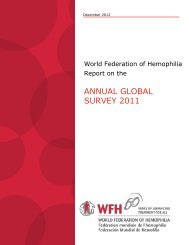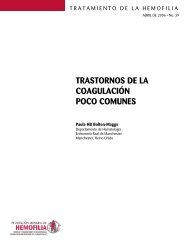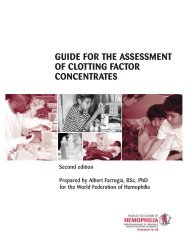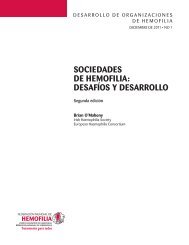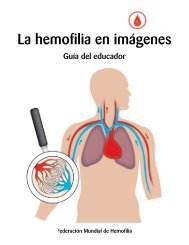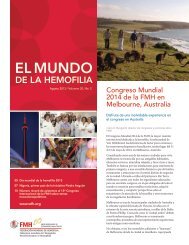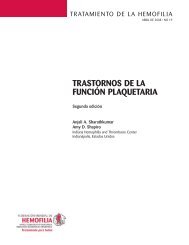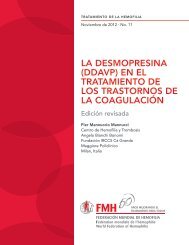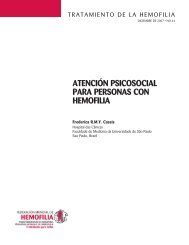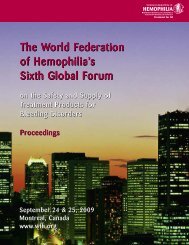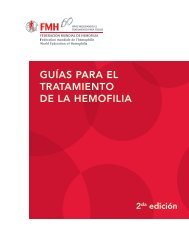Guidelines for Dental Treatment of Patients with Inherited Bleeding ...
Guidelines for Dental Treatment of Patients with Inherited Bleeding ...
Guidelines for Dental Treatment of Patients with Inherited Bleeding ...
Create successful ePaper yourself
Turn your PDF publications into a flip-book with our unique Google optimized e-Paper software.
<strong>Guidelines</strong> <strong>for</strong> <strong>Dental</strong> <strong>Treatment</strong> <strong>of</strong> <strong>Patients</strong> <strong>with</strong> <strong>Inherited</strong> <strong>Bleeding</strong> Disorders 7conjunction <strong>with</strong> metronidazole. Erythromycinmay be effective in people <strong>with</strong> penicillinallergies, but it may not be suitable <strong>for</strong> moresevere infections [34].Clindamycin produces high alveolarconcentrations [35], and bactericidal activity isreached <strong>with</strong> the usual recommended oral dose<strong>of</strong> 150 mg every 6 hours. In more severe cases itcan be given intravenously. It has been reportedthat clindamycin can cause antibiotic-associatedcolitis and there<strong>for</strong>e is <strong>of</strong>ten reserved <strong>for</strong> thetreatment <strong>of</strong> the more serious infections or whenpenicillin has failed [33,34].Periodontal infectionPeriodontal pockets host a variety <strong>of</strong> differentbacteria, the majority <strong>of</strong> them being anaerobic.Regular oral hygiene prevents these bacteriafrom causing gingival inflammation.In patients <strong>with</strong> severe gingival inflammation, inparticular those who are immune compromised,the use <strong>of</strong> an antimicrobial agent may beindicated. Metronidazole is considered the drug<strong>of</strong> choice due to its action against anaerobicorganisms. It may be used in conjunction <strong>with</strong>either penicillin or erythromycin. However,antimicrobial therapy is no substitute <strong>for</strong> oralhygiene treatment.Topical treatmentThe most common <strong>for</strong>ms <strong>of</strong> topical treatmentinvolve the use <strong>of</strong> an antibacterial mouthwash.These have value as an adjunct to hygiene phasetreatment. The most common treatments are:• Chlorhexidine gluconate: Chlorhexidine isavailable as a mouthwash, spray, andtoothgel. It is most commonly used as atwice a day mouthwash <strong>with</strong> the patientrinsing their mouth <strong>with</strong> the solution <strong>for</strong> 30–60 seconds. The toothgel may be used inaddition to the mouthwash. chlorhexidinehas a tendency to stain teeth so the length <strong>of</strong>each course <strong>of</strong> treatment should be limited.• Povidine-iodine: povidine-iodine isavailable as a mouthwash and can be used<strong>for</strong> the treatment <strong>of</strong> acute periodontalproblems. In addition, it may be useful toirrigate the periodontal pockets. It must beused <strong>with</strong> caution during pregnancy.<strong>Dental</strong> emergencies<strong>Dental</strong> emergencies can occur at any time;however, it is important to remember that notreatment should be carried out <strong>with</strong>out priorplanning as this could result in additionalproblems.The most common dental problems are pain dueto caries and bleeding from the periodontaltissues. Pain related to caries can usually betreated <strong>with</strong> either antibiotics or pulpectomy inorder to allow time <strong>for</strong> the planning <strong>of</strong> theextraction. <strong>Bleeding</strong> from the periodontal tissuescan usually be controlled <strong>with</strong> antibiotics until anappointment <strong>with</strong> a hygienist can be arranged.The management <strong>of</strong> dental trauma is morecomplex as it usually involves both the gingivaand the teeth. Local measures will usually controlgingival bleeding and temporary splinting can beused <strong>for</strong> fractured or loose teeth.With dental trauma, it is important to rememberthat we are part <strong>of</strong> the comprehensivehemophilia care team treating these patients.<strong>Treatment</strong> planning <strong>for</strong> an emergency requiresinput from the whole team to reduce the risk <strong>of</strong>further problems.ConclusionThe monograph has been written to helphealthcare workers develop local guidelines <strong>for</strong>the management <strong>of</strong> patients <strong>with</strong> inheritedbleeding disorders. They should be studied inconjunction <strong>with</strong> the two previously publishedWFH monographs Primary <strong>Dental</strong> Care <strong>of</strong> <strong>Patients</strong><strong>with</strong> Hemophilia [18] and Oral Care <strong>for</strong> People <strong>with</strong>Hemophilia or a Hereditary <strong>Bleeding</strong> Tendency [36].We should like to thank the members <strong>of</strong> thedental committee <strong>for</strong> their help and support inthe development <strong>of</strong> these guidelines and hopethat they help hemophilia healthcare workersthroughout the world improve dental care <strong>for</strong>their patients.



